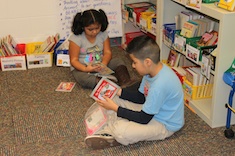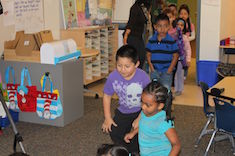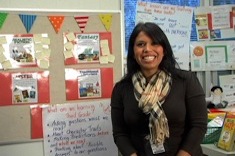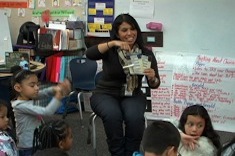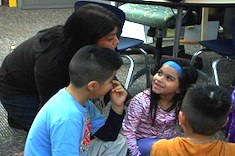I don’t understand why they just didn’t call the school if they wanted to find out more . . .
Did they just show up late to their meeting?
When there’s a classroom event, it’s like her complete family tree shows up!
Why haven’t they learned to speak English yet!
These voices were coming from the hallways. A group of educators had gathered after school to vent with one another about what they saw English learners and their families doing in our schools. There were questions. There was judgment. But I waited to hear signs of curiosity or wonder. There was silence. “There is so much to understand” is what I wish I had said. But I didn’t.
Instead, I went into my office trying to understand why these conversations were happening in our school community. Why were there misunderstandings? What was the fear? Why was there so much judgment? Where was the opportunity for learning and further conversations?
And then it hit me.
As an ELL instructional coach, I have spent a lot of time teaching strategies and sharing tools for teaching English learners. But I had not dedicated time for us to learn and talk about cultures. I needed to be more intentional about making sure we were having these conversations.
Learning and teaching English is more than learning sounds, words, and grammar. It’s more than teaching students how to read and write. It’s also about teaching not only our students but also our staff that our deep cultural roots are how we make sense of the world. They guide our behavior wherever we are. Some of these behaviors are unknown to us because we don’t share the same deep cultural roots and identity.
Later that year, we had two difficult scenarios, and I knew then that I couldn’t waste any more time. It was time for difficult conversations.
Lesson 1: Meet More Often
“I understand what you are saying, Mrs. Roberts. What I don’t understand is why you waited until February to tell us all of this. ”
Those were the painful words of a concerned parent after being told during a parent-teacher conference that their child was struggling significantly in math. I was sitting at this meeting. I was there as Ramatu’s ELL teacher. As I watched these parents make sense of Ramatu’s academic struggles, I realized how our traditional system of holding two parent-teacher conferences a year was making teachers new to the profession think that this was a golden rule you should abide by.
The message our school system was sending was this: We communicate with families only twice a year. In those 15 minutes allotted, I will share with you every detail and concern I have about your child’s progress. The message that our culturally and linguistically diverse families perceived was This is how we run schools in America. Please wait patiently for those allocated months for meetings. During that time, you’ll be told about any concern we might have.
It stung to sit there and watch a family be completely shocked to hear about their child’s struggles. No one had communicated directly and honestly with them about Ramatu’s difficulties in math. No teacher should wait until February to have those hard conversations with families.
Parents also have the right to be explicitly told how our American schools work. The message that our culturally and linguistically diverse families should receive at the beginning of the year is Please reach out to us at any point during the year to talk about your child’s progress. You don’t have to wait until parent-teacher conferences to talk. It’s okay to set up appointments with me during the year. In many cultures, you respect the teachers’ time. Families don’t believe it’s appropriate to take somebody’s time away unless you are explicitly invited.
Lesson 2: Include Students in Family Discussions
“Miguel has a hard time following the rules in the classroom. He often needs to be reminded of the proper ways we work together in this community.” The teacher explained this to Miguel’s family while he browsed through some books in the classroom library.
“Come here, mijo,” Miguel’s dad said. “I need you to hear what your teacher is sharing about your behavior. This is very concerning to me.” As Miguel’s dad said this, he pulled up a chair so Miguel could join the meeting with the classroom teacher. Mrs. Montgomery was surprised that Miguel was joining the conversation; she was hoping she would have a chance to talk with just his dad, without Miguel present.
Later that day, Mrs. Montgomery shared this moment with me. She was puzzled and confused by Miguel’s dad behavior. “Stella, I just wanted to talk to Miguel’s dad only. But he asked his son to be part of the meeting. If this happens to me again, how can I navigate that? What should I say?” I knew Mrs. Montgomery wanted to help all of her students succeed. I also knew that she had been struggling with Miguel’s behavior for several months.
But the truth was that there wasn’t anything to “navigate.” There was nothing to fix for next time. I carefully told Mrs. Montgomery that what had just happened was that Miguel’s dad had shared with us an important part of his family culture and point of view: They don’t shelter their children from hard conversations. The children are part of the dialogue and part of the solution. Those are their beliefs, and even if they are culturally opposite from ours, we should respect them. As Zaretta Hammond notes, “It’s important for us educators to understand how our own cultural values shape our expectations in the classroom.” Those expectations also shape our expectations of families.
Moving Forward
This work is not easy. There is no instructional manual that we can read to become consciously aware and informed of all the different cultural practices and beliefs. This kind of work requires
-
listening with grace and suspending judgment when we hear or see something “different” from our own cultural values;
-
living in a place of wonder and curiosity to seek understanding; and
-
honoring the way in which our students fully show up in our classroom without trying to make them “fit” to our standards.
Practicing a pedagogy of listening and cultivating a sense of wonder without judgment is a daily challenge. But it’s necessary work if we want to fully acknowledge our culturally and linguistically diverse families and appreciate all aspects of them.




